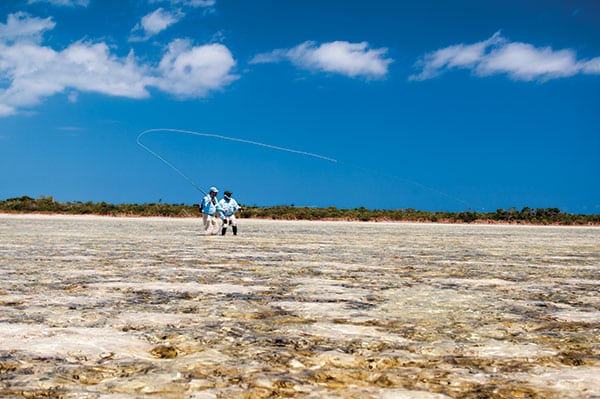
top tips casting
The most alluring aspect of fly-fishing also ranks as the most intimidating. In the hands of an accomplished caster-in-the-know, fly deliveries look pretty, and simple. However, in the hands of a newbie, onlookers notice an abundance of flailing and undeveloped loops. These eight tips can put you on the road to learning how to cast a fly rod, and help you acquire a feel for proper execution. Once you feel it, you are on your way to achieving the perfect cast.
Breaking the Wrist
Those who are learning how to cast a fly rod should think of the rod as an extension of the arm. By stabilizing the wrist of your casting arm and stopping your casts sharply, you will naturally be introducing the desired deflection in the tip, the casting portion of the rod. Once you develop the feel, you may begin to slightly break your wrist at the very end of the backcast or forward cast to fine-tune delivery.
Flinging Paint
When casting, try to think of holding a loaded paint brush and trying to splatter the paint against a wall. If you bring your arm back or forward too fast, paint will fall off the brush and land at your feet. If you bring your brush hand back slowly and come forward slowly, stopping sharply without breaking your wrist, paint will fly off the brush and splatter onto the wall. A fly cast works the same way.
Practice Fly vs. No Fly
Good instructors know that practicing with a proper leader and a practice fly develops the proper technique. A practice fly and a leader include two variables that will always be present on the water. This is certainly a good idea for most of your practice, though sometimes cutting off the practice fly will reveal errors in your casting stroke. For example, if you don’t have a fly on the end of your leader, you will hear a crack: The transition from backcast to forward cast is too strong or poorly timed. A crack indicates the need for adjustments.
Set Goals
Long presentations to unsuspecting fish are the shots we relish, but in reality, casts in the 30- to 50-foot range are the norm. Still, the ability to cast a distance remains a worthy skill to develop. Gaining distance comes easiest when you set goals for yourself. Cast at close-range targets until you can hit them consistently, then gradually move them farther away as your mastery develops.
In the Wind
Casting in a sterile environment allows you to hone the basics of the cast, but anglers know that on the water, the wind blows 95 percent of the time. Therefore, practice in windy conditions as much as possible. In a stiff wind, cast at your targets from all angles so you can learn how to adapt your stroke no matter what direction the breeze hits you and the fly line.
Keep an Eye On It
Part of the process of developing a feel for casting requires watching your line in the air. In the early stages of learning, stand sideways, and observe each back and forward cast. Remember, the fly line should appear to unroll evenly in both directions. If it doesn’t, adjust your stroke until it does.
Shoot for Distance
Anglers should always use a minimum of false casts to make a delivery; most good anglers can make a great presentation in three false casts or fewer. The key to reducing false casts is to shoot for distance. Think of your false casts as a means of getting enough line out of the rod tip — with enough line speed — to carry the running line to the target. To make an 80-foot cast, don’t try to carry it all in the air. Instead, false-cast 40 feet in two false casts, and then shoot the remainder of line on the third.
Keep It in the Air
Simply keeping your fly line in the air on both the forward cast and backcast ranks as the best way to quickly develop tight loops. Start with short line, maybe 30 feet or so, and begin false-casting without letting any more line out. The goal is to continue false-casting without letting any portion of your casting line touch the ground. This naturally helps you learn to develop tight loops.
Master these fly fishing tips and you’ll be catching fish in no time.









